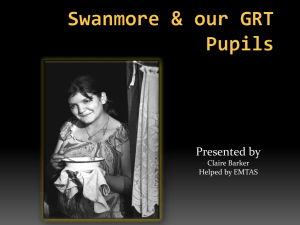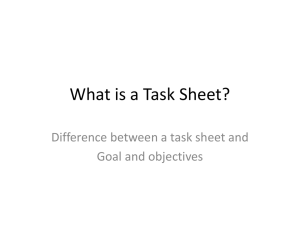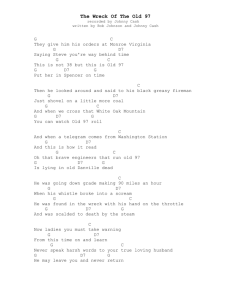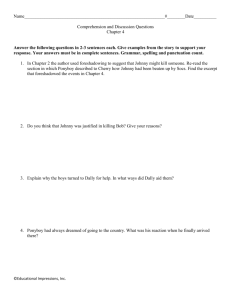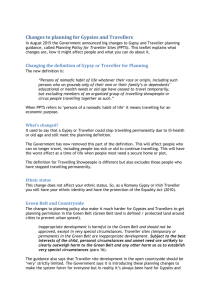Inclusive Work with Young People Pack
advertisement
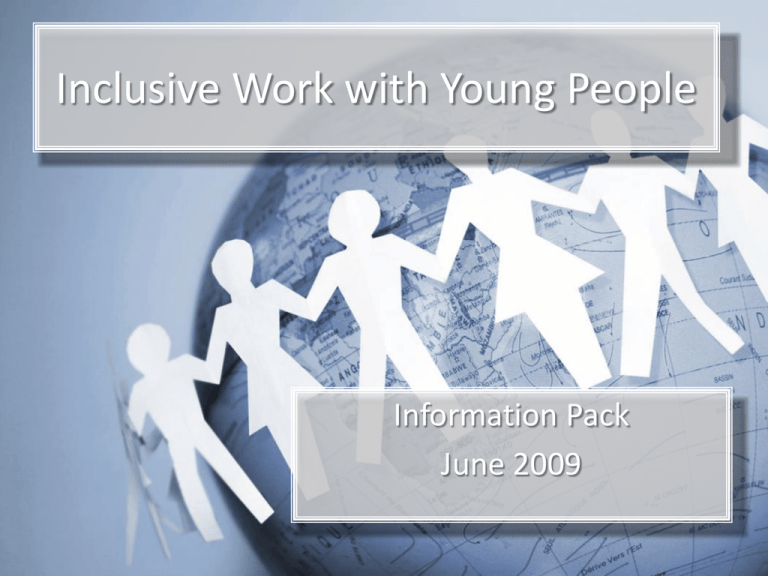
Inclusive Work with Young People Information Pack June 2009 Useful Websites Introduction Session 1: Identity MATERIALS: Flip chart/whiteboard, worksheets: identity profile, welcome action plan ICEBREAKER: Go round the circle, everyone says 1 truth about themselves and 1 lie, other have to spot which is the truth and what’s the lie. What does this say about us and our identity? Do we sometimes lie because we think we’re not smart enough, or cool enough? We all make assumptions about people based on the way they look and what they say. Do we need more to establish identity? ACTIVITY 1: Forms of ID – Ask the group to name forms of ID, and write them up on a flipchart. What info do ID forms ask for and what does that information tell us about people (gives us their background but doesn’t tell us about them as a person). Are ID cards a good or bad thing? Good because we know who people are can keep tabs, bad because an invasion of privacy, you’re more than an ID card. ACTIVITY 2: Personal profile – hand out sheets and get each young person to complete. List things that identify you as a person (red hair, freckles, long legs) then groups you’re a part of. Now ask each young person to add: • A group people assume you’re part of but you’re not e.g. your parents religion; a group you wanted to be part of but weren’t included (e.g. older siblings friends) • Feedback: why do we choose to be part of a group, and why some groups rather than others? And what does it feel like when you want to be part of a group but the group rejects you? Session 1: Identity ACTIVITY 3: Welcome to our centre. Hand out role play cards and ask each group to think about how they would welcome this young person to the centre. Hand out the worksheets for them to make an action plan. They can include the local community and also need to make a list of what workers need to do to make the centre inclusive and welcoming. Think about questions like: • What would make your centre safer and more accessible • What language and behaviour is appropriate (do you already have a charter or code of conduct?) • What responsibility do workers have and could they do more? • Is there any additional support you would like? Feedback: make a list of most common suggestions and pin this up somewhere so you can remember to act on it. If you already have a set of guidelines for your centre, review the in the light of this discussion. EVALUATION: Use a talking ‘stick’ to get each young person to summarise what they felt they learnt during the session. EXTENSION ACTIVITY: Either produce a pack, with information about the centre, local community, things to do or design a welcome website (using Word or Publisher). Session 1: Leader’s Notes The personal profile sheet from Activity 2 could be used for Youth Achievement Awards. The role play cards are suggestions only – if you feel that any would be inappropriate for use with the group you are working with then please amend them or substitute your own suggestions. You could use the activity sheets with young people who may be fairly new to your centre, asking their opinion on what you could do to make your centre as welcoming as possible. Role Play Cards An out lesbian or gay young person who has been the victim of ‘gaybashing’ A young person in a A young person wheelchair with Aspergers who has difficulty making friends A young asylum seeker who doesn’t speak English very well A young traveller who has just arrived in the area A black young A Muslim young person who is being person who needs bullied somewhere to pray A young person who has recently lost a leg in an accident This is me – my personal profile Paste your photo here Groups I’m a part of Personal Stuff Hair colour Eye colour Height The think I like best about myself is Something that makes me stand out from the crowd Something that I have in common with my best mate Welcome to my centre – Action Plan Session 2: Not in My Back Yard (with thanks to the BBC and Holocaust Memorial website) MATERIALS: Nellie’s letter, Johnny’s story, true or false information, activity sheets for roleplay debate. ICEBREAKER: ACTIVITY 1: Read out the story of Johnny Delayney – in pairs think of: • Reasons why a passerby wouldn’t get involved • Reasons they would give for not getting involved • What will happen to the bullies if they’re not stopped • What would happen if 1 person tried to stop them • What would happen if a group of people tried to stop them A2: Now read out the rest of Nellie’s letter – on a flipchart list: • The positives and negatives of traveller life • The positives and negatives of your own life if you’re a non traveller – what are the similarities and differences, if any? Session 2: Not in My Back Yard (with thanks to the BBC and Holocaust Memorial website) ACTIVITY 3: Traveller Issues Quiz – the statements are agree or disagree. Use responses to spark debate (facts are included in leader’s notes). Feedback: did the group realise the issues that face GRT young people? Are they very different to the issues that affect all of us? ACTIVITY 4: Roleplay debate – read the information on the activity sheet about the proposed traveller camp at ____________ As a group decide who the main protagonists are (traveller families and children, council members, people who live next to the proposed site). Then assign a role to each member of the group or divide the group into smaller groups who each assume a role. Thinking in character, ask them to brainstorm some of the major arguments – will affect house prices, we have a right to access clean water and healthcare, UN rights of the child, civic responsibility towards all people in the county etc. Most of the information you need will be on the sheet. Give the groups a few minutes to prepare what they’re going to say, and to think of good counter arguments and then bring the group together for the debate. You are the final arbiter in front of whom all groups must present their argument. Then allow time for open debate (keep this controlled and don’t allow inappropriate, abusive or racist language) and finally ask for summing up from each group. Remind them that they really have to convince you as to whether the site can go ahead or not. EVALUATION: as individuals, taking into account all the arguments they’ve heard and some of the information they have about GRT issues, ask the group to vote on whether the site should go ahead or not. Then ask individuals why they made that decision and what they think they’ve learned from the session. EXTENSION ACTIVITY: Why not contact your local young travellers group (e.g. Youth action at New House) and arrange a GRT evening when young people can find out more about the GRT way of life and the issues that affect GRT young people. Session 2: Leader’s Notes ACTIVITY 1 & 2 Johnny’s Story/Nellie’s Letter – Read Johnny’s Story first, then the rest of Nellie’s letter that talks about Traveller life and the strong family connections. ACTIVITY 3: the information in these true/false statements is taken from the Gypsy Roma Traveller History Month website: http://www.grthm.co.uk/myths-and-truths.php These statements are deliberately contentious but only use those that you feel comfortable discussing and challenge any inappropriate language. Two sites are of particular interest and have a wealth of resources and stories for building empathy between young people: YOUTH DIVISION was set up to support young travellers, gypsy and Roma who are feeling socially excluded or being bullied – there are a series of stories and an active message board: http://www.youthdivision.moonfruit.com/# CYBER PILOTS is aimed at young people but includes a range of valuable resources for those working with GRT young people, as well as stories, poems and videos: http://www.gypsy-traveller.org/cyberpilots/ Clearly one session cannot hope to embrace the rich history of Gypsy Roma Traveller culture but to find out more, try visiting some of the websites that give an insight into GRT tradition: http://www.kent.gov.uk/Community/equality-and-diversity/gypsies-and-travellers/ Information from Kent.gov.uk Nellie’s Letter – Johnny’s Story I would like to tell you the very sad story about what happened to my 15 year old brother Johnny in 2003. It was my Aunt Margaret’s 50th birthday and she had arranged to have a special birthday party for everyone to attend. My brother Johnny went over to Ellesmere Port to invite two of his friends over to join the family party. It was a hot summer’s day. So on the way home they went into a shop to buy some potato crisps and lemonade. But there were some nasty boys inside the shop and they started to threaten Johnny and his friends and call them horrible names. When the boys left the shop, Johnny asked the shopkeeper if he could look to see if it was safe for them to go outside. “Yes, the man said, “it looks like they have gone now”. When they got outside, Johnny and his friends decided to take the short cut home across the park. But the eight boys appeared from nowhere, and started to chase Johnny and his friends across the field. Johnny’s friend got caught, so Johnny went back to help him. He managed to get him free, but Johnny got caught. The nasty boys then started kicking Johnny in the head and chest until finally Johnny died. A man was passing by walking his dog; he shouted at the boys “Why did you do that”? One of the nasty boys shouted back to him “He deserved it , he was only a ******* Gypsy”. It really hurt all our family to lose Johnny this way. My mother and father were very upset and would cry all the time. Two years later my father, Patrick, died too. Mummy said that he died of a broken heart. My little brother Paddy is now aged 7 but he doesn’t seem to understand. He thinks his Dad and brother have gone away travelling and will soon be back. Nellie’s Letter Dear Friends, I would like to tell you about the awful thing that happened to my brother Johnny. My name is Nellie Delaney and I am now 15 years old. I live with my Mother and my two sisters, and my younger brother Patrick. We are an Irish Traveller family and we live in the City of Liverpool in England. It’s really good being from a Traveller family because we get to travel all over England and we get to see interesting places and meet lots of different people. Best of all though, is always being together as a family and growing up with cousins, uncles and aunts and grandparents always nearby. Whenever there is a family birthday or celebration, we are all there to enjoy it together. It’s also good being a Traveller child because we have lots of fun and laughter. My older brother Johnny was my favourite brother; he was always making us laugh. When we were little we always had lots of pillow fights. He taught us how to play Blind Man’s Bluff and other games, and it was really funny when he taught my little brother Paddy how to Break Dance, we laughed so much that day! He also taught my little sister Eileen how to read. Another time, our cousin Ann-Marie was staying with us and she decided to make us all some toast. But as fast as she made the toast, the pile kept on getting smaller and smaller….she couldn’t understand why? Then she saw that Johnny was feeding the toast to us from the window! We all had breadcrumbs and warm butter around our mouths. That was the best toast ever, and it was good seeing Johnny’s smile. In school I have lots of friends too, but sometimes when we are travelling we meet people who are nasty to us. Most people we meet are okay with us and are good mannered to us. We help to make their homes and communities nice by tidying up their trees and improving their houses and driveways, and selling them pretty flowers at the market. But some people we meet are not nice at all and are prejudiced against us. They say nasty things to us and say they don’t like Travellers. I don’t know why. GRT culture – true or false? GYPSIES ARE FOREIGN False: Gypsies and Travellers have been part of British culture for at least 500 years GYPSIES ARE DIRTY False: there are very strict codes of cleanliness in Gypsy life – in fact they view non-Gypsies as dirty for letting animals in their houses GYPSIES WERE PERSECUTED BY THE NAZIS True: as many as half a million Gypsies died in the Holocaust and had to wear special symbols (an upside down triangle) on their clothes. ALL GYPSIES LIVE IN CARAVANS False: In fact, 90% of Gypsies worldwide now live in houses – they bring their culture with them GYPSIES RAN AWAY IN THE WAR False: Many Gypsies and travellers fought for Britain in both world wars winning a number of Military Medals and at least one Victoria Cross – traveller and Gypsy family names are on war memorials all across the UK and Europe GYPSIES AND TRAVELLERS DON’T CONTRIBUTE TO BRITAIN False: As self employed workers, Gypsies and travellers pay taxes like anyone else. And as the fastest growing ethnic minority in Europe, they make a huge contribution both as workers and to our culture. GYPSIES CAN CURSE YOU: False: To defend themselves, Gypsies and travellers have sometimes used the mystery that surrounds their origin and culture to let people believe they have ‘special powers’. In fact, anybody in the population might have psychic powers – including you! Council Plan New Traveller Site near Residential Area Anger erupted yesterday over the council’s controversial plans to situate a traveller’s site on the edge of a residential estate. ‘It is intolerable that the council would do this without asking us, the taxpayers, what we think’ said head of the resident’s committee, Daphne Keeling. ‘The disruption and mess will have a huge impact on house prices’. Councillor Hugh Jackson said ‘everybody has a right to clean water and healthcare. These are basic human rights that are often denied to the traveller community. We ‘ However, his view is not shared by everyone in the council. Councillor Dean French said ‘I share the objections of the people I represent and think the council are imposing their views without asking what people want. A representative of a gypsy traveller group (who asked not to be named) thanked councillors for their ‘brave’ decision and the increased role that Session 3: Disability – Myths & Misconceptions (with thanks to the DRC) MATERIALS: Quiz questions and answers, disability audit sheet, flip chart, post-its ICEBREAKER: Say what! So what? Read out the following statements and ask young people to decide whether they’re say what (negative stereotyping) or so what (don’t care) statements – discuss after each statement: • Despite being in a wheelchair, he still manages to live a normal life (implies being in a wheelchair is not normal) • I’d like you to meet Chantelle. She’s the cleverest black pupil in the school (draws attention to her ethnicity in a way that wouldn’t happen with a white pupil) • We’d like to welcome you all to our hotel – we have a football match set up for the men and cookery classes for the ladies (gender stereotyping) • The job is open to women and other minorities (implies that women are a minority and that women and people from a minority background who wish to find a job are the exception not the rule) • Even though she has learning difficulties, Jarmilla manages to enjoy school (implies that heaving learning difficulties mean you can’t enjoy life) ACTIVITY 1: role play excluded/included. This will have 3 scenes: • A scene where someone is excluded – because of a disability, because they’re being bullied • The problem is confronted – parents complain, a group of young people confront the bully • The problem is resolved – workers resolve the situation, anti bullying measures are taken Don’t spend too much time on rehearsal or presentation – concentrate on the feedback: • What did it feel like to be excluded from a group for something you couldn’t control? • Do you feel that enough was done to resolve the situation? Session 3: Disability – Myths & Misconceptions (with thanks to the Disability Rights Commission) ACTIVITY 2: Disability myths and misconceptions. Present this as a game show with either yourself or a young person in the role of quizmaster. Agree on the format of the show – teams or individuals, head to heads or taking it in turns to answer then use the questions to stage the show. Feedback: What did young people learn? Did they have their assumptions challenged? What was the most important message they would take away from the quiz? ACTIVITY 3: Design a game. Divide the group into 3 or 4 smaller groups and ask them to design a game that shows the challenges facing young people with disabilities – they can use an existing game as a template or come up with something new. Feedback: do they think the measures they have built into their game would be successful at helping young people with disabilities be included at their centre? EVALUATION: Give each member of the group a post-it note and ask them to draw a smiley, tick or a cross, or write a couple of words in answer to the following questions then stick to the flip chart • Did you enjoy the session? • Did you learn something from it? • Would you like to find out more? EXTENSION ACTIVITY: Do a disability audit of your centre – look at accessibility issues not just in terms of the building but the information you have available, computers etc. How could you improve accessibility and make your centre more welcoming for young people with disabilities? Use the attached sheet or devise your own and remember to revisit in 6 months time. Session 3: Leader’s Notes It’s important to make it clear in this session that disability doesn’t only include what you can see (a wheelchair, missing limb, a white stick or a dog) but also the disabilities you can’t see – dyslexia, learning difficulties, autism. The NUS has a good briefing on hidden disabilities with links to useful websites here: http://resource.nusonline.co.uk/media/resource/hidden%20disabilities%20briefing.pdf Handigo is an excellent collection of 3 mini browser games where players take on the roles of different characters with disabilities – the game is available here: http://www.handigosolidaires.com/en/goodies/index.html Session 4: What is ‘Britishness’ (with thanks to the BBC and Stockport Inclusion) MATERIALS: Flip chart & marker pens, activity sheets – language, poem & wordsearch, citizenship quiz sheets, paper plates or alternative (see icebreaker), appropriate materials for extension activity (see below) ICEBREAKER: Commonalities Game: ask the group to form a circle with 2 in the middle. Each person in the circle will stand on a paper plate. Find something that the 2 people in the circle share in common, like age. Everyone else who shares that commonality must move to a new plate. As they move, take away a couple of plates so 2 people end up the centre. Repeat, taking away more plates each time so that more and more people end up in the centre because they share things in common. ACTIVITY 1: Are you an American? Take the test (see leader’s notes - these questions are from the American citizenship test) – if you failed any of the questions you can’t be an American. But if you did fail, does that mean you wouldn’t fit into American society? And if you studied specially for the test and then passed, would that mean you had changed as a person? Now take this test (see leader’s notes) – did you pass this test? If you didn’t then you’re not British! Do you think that studying for a test and passing it makes you part of that country? Now think of your own test and what questions would be important to you to ask – brainstorm this in the group and come up with 10 questions for your ‘Britishness’ quiz. Encourage discussion as the questions develop. What do they say about what you think ‘Britishness’ is? ACTIVITY 2: Where do we come from? Make a list of of Britain’s top sportsmen – do they conform to the stereotypical image of a ‘Brit’? Be sure to mention people like Kelly Holmes, Tanni Grey Thompson, Colin Jackson, David Beckham (has OCD). Are they all ‘British’ even though their backgrounds are different? What are their commonalities and their differences? What are the qualities that make them ‘British’? Do you think only ‘British’ people have those qualities or are they shared by many people regardless of their ethnic background? Hand out the words sheet – split the group into small groups and ask them to complete the sheet guessing whether words are Indian , French etc. Now go over the answers – were you surprised at how many words that you think are English come from other languages? Session 4: What is ‘Britishness’ ACTIVITY 3: Now read the poem ‘The British’ and hand out the sheets. What did the group think of the poem? Were they surprised at the number of different nationalities that make up the ‘British’? Does it alter their view of ‘the Bristish’? Did they realise how many different tribes and people from different countries make up ‘the British’? Now complete the wordsearch – can you find some of the many different peoples that make up the UK that are mentioned in the poem? EVALUATION: Target evaluation – draw a target on the flip chart/whiteboard. The Bullseye is ‘strongly agree’, then ‘agree’, ‘disagree’ and ‘strongly disagree’. Then ask the following questions and ask the group to mark on the target whether they agree/disagree: • Did you agree with the poem? • Do you think Britishness depends on passing tests? • Do you agree with the statement ‘all different, all equal’? • Did you enjoy the session? EXTENSION: Write your own poem/rap/song lyric about your own feelings about ‘Britishness’ and the ‘British’, or produce a piece of visual art. Session 4: Leader’s Notes ACTIVITY 1: Deliver these yourself, reading out the questions and inviting discussion around the possible answers. The answers to the questions are given on the sheet. If young people would like to see if they can pass the UK test, there’s a short online test available here: http://news.bbc.co.uk/1/hi/magazine/4099770.stm ACTIVITY 2: If young people would like to find out the origin of some of the common ‘English’ words we use, there is a comprehensive list available at Wikipedia – guessing the origin of some of our most used words could be easily expanded as an activity: http://en.wikipedia.org/wiki/Category:Lists_of_English_words_of_foreign_origin ACTIVITY 3: Benjamin Zephaniah’s work is instantly accessible for young people who can find out more here: http://www.benjaminzephaniah.com/content/index.php There are several excellent poems on the BME experience in Britain. You could also contrast Zephaniah’s view with those of Linton Kwasi Johnson whose poem ‘Sonny’s Letter’ paints a dark picture of the BME experience http://lister.ultrakohl.com/homepage/Lkj/sonny.htm The wordsearch takes some of the major migrant groups that have shaped the UK – it should be quite clear that Britain is a ‘mongrel’ nation and that what we think of as ‘British’ has been shaped by wave after wave of migration to these shores. The Moving Here website covers the last 200 years of migration with stories, images and resources to trace your family tree: http://www.movinghere.org.uk/ A potted history can be found here: http://www.thefreelibrary.com/U.K.+kids:+who+are+the+British%3F-a0128205900 A British history timeline is available here: http://www.bbc.co.uk/history/british/launch_tl_british.shtml Citizenship Test 1. 2. 3. 4. 5. 6. 7. 8. • • • • • • What are the colours of the American flag? How many stars are on the American flag? Who is the American president? Who is the vice president? How many amendments are there to the American constitution? Are you over 18? Can you speak English? How many states are there in the USA? 1. 2. 3. 4. 5. The American flag is red, white and blue It has 50 stars Barrack Obama Joe Biden 27 (the most famous was Prohibition, which banned the sale of alcohol) There are 50 states in the USA (each star on the flag represents a state) • • • • • 6. 7. 8. • • • What are MPs What does PG stand for? Where is the Scouse dialect spoken? When did Queen Elizabeth II start her reign? When you buy a dog what must you get – a license, have the dog neutered, get a collar and dog tag? St Patrick’s Day is the national day of which country? At what age can you vote in the UK? Where do midwives work? Members of Parliament Parental Guidance (not a type of tea!) Liverpool 1952 Get a collar and dog tag (there’s no dog license and neutering is recommended but not a legal requirement) Ireland 18 Health centres and hospitals The language we speak in Britain is English. But do you know that most of the words we use everyday come from French, German and Latin. The English language reflects the different origins of the people who live here – but can you work out what language the following words come from? WORD Bungalow Mascara Kilometre Dollar Chemistry Robot Pajamas Jazz Bacon Cola INDIA AFRICA ARABIC FRENCH CZECH The British by Benjamin Zephaniah Take some Picts, Celts and Silures And let them settle, Then overrun them with Roman conquerors. Remove the Romans after approximately 400 years Add lots of Norman French to some Angles, Saxons, Jutes and Vikings, then stir vigorously. Mix some hot Chileans, cool Jamaicans, Dominicans, Trinidadians and Bajans with some Ethiopians, Chinese, Vietnamese and Sudanese. Then take a blend of Somalians, Sri Lankans, Nigerians And Pakistanis, Combine with some Guyanese And turn up the heat. Sprinkle some fresh Indians, Malaysians, Bosnians, Iraqis and Bangladeshis together with some Afghans, Spanish, Turkish, Kurdish, Japanese And Palestinians Then add to the melting pot. Leave the ingredients to simmer. As they mix and blend allow their languages to flourish Binding them together with English. Allow time to be cool. Add some unity, understanding, and respect for the future, Serve with justice And enjoy. Note: All the ingredients are equally important. Treating one ingredient better than another will leave a bitter unpleasant taste. Warning: An unequal spread of justice will damage the people and cause pain. Give justice and equality to all. LiAnswer Answer Printable Printable sSearch t thihome/ape sSD puzzlKey Key e forHTML PDF the HTML PDF public U Wordsear regan.pp@ /_xclick 0 13 http://www armoredp 2 1 pub-6918 en GALT:#00 active ISO-8859 6346442 Being ‘British’ Wordsearch PICTS Ancient Scottish tribes CELTS Tribes from Spain, Brittany, Cornwall & Wales SILURES Ancient Welsh tribes ROMANS From Italy and the Roman Empire NORMANS Vikings from France & Italy VIKINGS From Scandinavian SAXONS Old Germanic tribes JUTES Germanic tribes who occupied Kent JAMAICANS The first Caribbean migrants arrived June 22, 1948 on the Windrush VIETNAMESE Arrived in the early 70s escaping the Vietnamese War PAKISTANIS Most are Commonwealth migrants (the Queen is head of the Commonwealth) BOSNIANS Many fled from the Balkans Conflict 1992-5 PALESTINIANS Refugees from ongoing Middle East conflict s i n a t s i k a p i e n e s r a n t c s b n l a a r s n a m r o n t g c n a u g i s s t i i o i i n e l n n n a b r i a o n n a i i t l n m s m p i m a t s k a t t e a t o n a s a p i l s j j r s e s e x i e v u t c g i c n l o c n t s n s e s e m a n t e i v t i a p s p p s s s n e i
